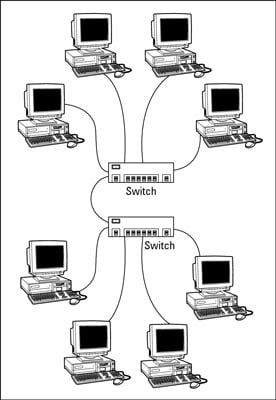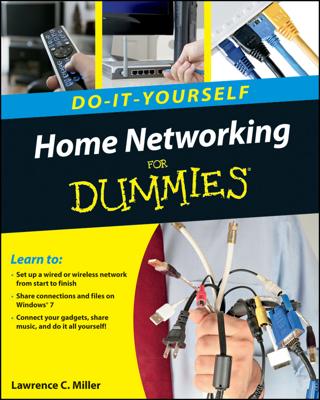When you use twisted-pair cable to connect build your computer network, you also must use a separate device called a switch. Years ago, switches were expensive devices — expensive enough that most do-it-yourself networkers who were building small networks opted for thinnet cable in order to avoid the expense and hassle of using hubs.
Nowadays, the cost of switches has dropped so much that the advantages of twisted-pair cabling outweigh the hassle and cost of using switches. With twisted-pair cabling, you can more easily add new computers to the network, move computers, find and correct cable problems, and service the computers that you need to remove from the network temporarily.
Note that in some older networks, you may see a device known as a hub used instead of a switch. However, the cost of switches came down dramatically, pushing hubs into relic status. If you have an older network that uses hubs and seems to run slowly, you can probably improve the network’s speed by replacing the older hubs with newer switches.
If you use twisted-pair cabling, you need to know some of the ins and outs of using hubs:
Because you must run a cable from each computer to the switch, find a central location for the switch to which you can easily route the cables.
The switch requires electrical power, so make sure that an electrical outlet is handy.
When you purchase a switch, purchase one with at least twice as many connections as you need. Don’t buy a four-port switch if you want to network four computers because when (not if) you add the fifth computer, you have to buy another switch.
You can connect switches to one another, this is called daisy chaining. When you daisy chain switches, you connect one end of a cable to a port on one switch and the other end to a port on the other switch. Note that on some switches, you must use a special designated port for daisy chaining.
 Daisy chaining switches together.
Daisy chaining switches together.
You can daisy chain no more than three switches together. If you have more computers than three hubs can accommodate, don’t panic. For a small additional cost, you can purchase hubs that have a BNC connection on the back. Then you can string the hubs together using thinnet cable.
The three-hub limit doesn’t apply when you use thinnet cable to connect the hubs. You can also get stackable switches that have high-speed direct connections that enable two or more switches to be counted as a single switch.
When you shop for network hubs, you may notice that the expensive ones have network-management features that support something called SNMP. These hubs are called managed hubs. Unless your network is very large and you know what SNMP is, don’t bother with the more expensive managed hubs. You’d be paying for a feature that you may never use.
For large networks, you may want to consider using a managed switch. A managed switch allows you to monitor and control various aspects of the switch’s operation from a remote computer. The switch can alert you when something goes wrong with the network, and it can keep performance statistics so that you can determine which parts of the network are heavily used and which aren't.
A managed switch costs two or three times as much as an unmanaged switch, but for larger networks, the benefits of managed switches are well worth the additional cost.

